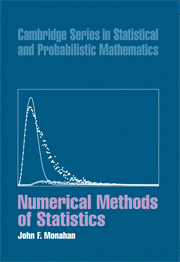Book contents
- Frontmatter
- Contents
- Preface
- 1 Algorithms and Computers
- 2 Computer Arithmetic
- 3 Matrices and Linear Equations
- 4 More Methods for Solving Linear Equations
- 5 Regression Computations
- 6 Eigenproblems
- 7 Functions: Interpolation, Smoothing, and Approximation
- 8 Introduction to Optimization and Nonlinear Equations
- 9 Maximum Likelihood and Nonlinear Regression
- 10 Numerical Integration and Monte Carlo Methods
- 11 Generating Random Variables from Other Distributions
- 12 Statistical Methods for Integration and Monte Carlo
- 13 Markov Chain Monte Carlo Methods
- 14 Sorting and Fast Algorithms
- Table of Programs and Demonstrations
- Author Index
- Subject Index
12 - Statistical Methods for Integration and Monte Carlo
Published online by Cambridge University Press: 21 March 2011
- Frontmatter
- Contents
- Preface
- 1 Algorithms and Computers
- 2 Computer Arithmetic
- 3 Matrices and Linear Equations
- 4 More Methods for Solving Linear Equations
- 5 Regression Computations
- 6 Eigenproblems
- 7 Functions: Interpolation, Smoothing, and Approximation
- 8 Introduction to Optimization and Nonlinear Equations
- 9 Maximum Likelihood and Nonlinear Regression
- 10 Numerical Integration and Monte Carlo Methods
- 11 Generating Random Variables from Other Distributions
- 12 Statistical Methods for Integration and Monte Carlo
- 13 Markov Chain Monte Carlo Methods
- 14 Sorting and Fast Algorithms
- Table of Programs and Demonstrations
- Author Index
- Subject Index
Summary
Introduction
One of the advantages of Monte Carlo methods, as highlighted in Chapter 10, is that the whole array of statistical tools are available to analyze the results and assess the accuracy of any estimate. Sadly, the statistical analysis of many Monte Carlo experiments has been absent, with others poorly done. Quite simply, statisticians do not always practice what they preach. One rationalization with some validity is that the statistical tools for analyzing these data are beyond the mainstream of statistical methodology; one of the goals of this chapter is to remove this as a possible excuse. Some of the fundamental statistical tools are reviewed in Section 12.2. Density estimation, long an object of theoretical discourse, becomes an important tool in expressing the results of Monte Carlo studies; a brief discussion of the highlights of density estimation is included in this section. The most common statistical tests for these data involve testing whether a sample arises from a specified distribution; a brief discussion of goodness-of-fit tests forms Section 12.3. Importance sampling, discussed briefly in Chapter 10, presents a class of statistical problems with weighted observations. This requires some minor modifications of common statistical tools that are outlined in Section 12.4. An attendant problem with importance sampling is concern for the distribution of the weights; tests on the behavior of the distribution of weights are discussed in Section 12.5.
The other goal of this chapter is to introduce some specialized integration tools. In Section 12.6, Laplace's method provides an asymptotic approximation for moments of a posterior based mainly on the large-sample normal approximation to the posterior.
- Type
- Chapter
- Information
- Numerical Methods of Statistics , pp. 319 - 350Publisher: Cambridge University PressPrint publication year: 2001
- 1
- Cited by



